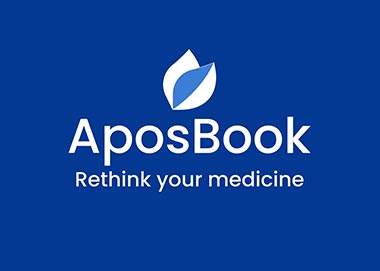Ready to leave?
Oops ! Condition name you have entered is invalid.
You are now leaving Aposbook.com and going to an external site managed by another organization.
Please confirm your email address and try to login again.
This account has been deleted. do you want to restore it?

Validate your email
A verification link will be sent to within the next 2 minutes. Please click it to validate your e mail.
*If you didn't get the link, please check your spam folder
Welcome to Aposbook,
As a registered user, you can benefit from the various free tools and services that we provide.
All you need to do is log in to start discussing with others, interacting, asking questions, and sharing your point of view about the various topics.
You can also write reviews and testimonials about any natural solution you have tried and share your experience. Your feedback can be very helpful.
If you are a health expert, you can add information about any topic or suggest text edit. You can also publish content, including articles and videos, about any topic from the related library section.
Together we can help.
The Aposbook Team
Forgot Password?
A validation link will be sent to you by email. Please confirm your address to log in
*If you didn't get the link, please check your spam folder
Please log in to use this feature
Your account has been suspended because you have violated our code of conduct. If you think this was a mistake, you can contact us by email at: support@aposbook.com "Contact us" form.
Success! Thank you for your feedback. Your contribution can make a difference. Together we can help each other.


Diet Programs
Anti-Inflammatory Diet For Guillain Barre Syndrome
Can Anti-Inflammatory Diet help For Guillain Barre Syndrome?
Complete Guide to Anti-Inflammatory Diet For Guillain Barre Syndrome
Possible triggers of GBS from the Anti-Inflammatory Diet perspective
Guillain Barre Syndrome (GBS) is a medical condition characterized by the inflammation of the nerves, including the peripheral nerves outside the brain and spinal cord. Sometimes the inflammation can be severe enough to cause degeneration of the whole nerve fibers.
One of its most common subtypes is called Acute Inflammatory Demyelinating Polyneuropathy (AIDP) or Landry's Ascending Paralysis.
Learn everything about Guillain Barre Syndrome (GBS) and find all the natural solutions to treat it naturally, including various ...
Possible triggers of GBS from the Anti-Inflammatory Diet perspective
Guillain Barre Syndrome (GBS) is a medical condition characterized by the inflammation of the nerves, including the peripheral nerves outside the brain and spinal cord. Sometimes the inflammation can be severe enough to cause degeneration of the whole nerve fibers.
One of its most common subtypes is called Acute Inflammatory Demyelinating Polyneuropathy (AIDP) or Landry's Ascending Paralysis.
Learn everything about Guillain Barre Syndrome (GBS) and find all the natural solutions to treat it naturally, including various diet programs, alternative medicine, vitamins, supplements, herbal medicine, and home remedies.
Why Anti-inflammatory Diet helps for Guillain Barre Syndrome / AIDP / CIDP:
The anti-inflammatory diet can help for treating and preventing AIDP / CIDP by reducing inflammation. This can help alleviate pain in the nerves and relieve various symptoms, which would contribute to treating this condition.
Research and studies have found that consuming specific foods with anti-inflammatory properties can help in reducing inflammation and pain, and hence can help in reducing AIDP / CIDP symptoms.
This is why many medical and health experts recommend following ...
Why Anti-inflammatory Diet helps for Guillain Barre Syndrome / AIDP / CIDP:
The anti-inflammatory diet can help for treating and preventing AIDP / CIDP by reducing inflammation. This can help alleviate pain in the nerves and relieve various symptoms, which would contribute to treating this condition.
Research and studies have found that consuming specific foods with anti-inflammatory properties can help in reducing inflammation and pain, and hence can help in reducing AIDP / CIDP symptoms.
This is why many medical and health experts recommend following an anti-inflammatory diet, and avoiding inflammatory foods such as pizza, red meat, butter, and cheese among many other foods.
How Anti-inflammatory Diet works for Guillain Barre Syndrome (GBS)
The anti-inflammatory diet focuses on certain types of foods that have beneficial healing effects and can reduce nerve inflammation.
The diet includes a variety of fruits and vegetables, whole grains and fish sources among others that are rich in omega-3 fatty acids, fibers and many other nutrients. These are known to reduce inflammation, and hence can help fighting AIDP / CIDP symptoms such as numbness and cramping of the limbs.
Furthermore ...
How Anti-inflammatory Diet works for Guillain Barre Syndrome (GBS)
The anti-inflammatory diet focuses on certain types of foods that have beneficial healing effects and can reduce nerve inflammation.
The diet includes a variety of fruits and vegetables, whole grains and fish sources among others that are rich in omega-3 fatty acids, fibers and many other nutrients. These are known to reduce inflammation, and hence can help fighting AIDP / CIDP symptoms such as numbness and cramping of the limbs.
Furthermore, certain types of foods consumed in the anti-inflammatory diet contain antioxidants that would work on reducing the level of free radicals. These free radicals are molecules that damage the cells in the body and can lead to inflammation if not properly controlled.
In addition, the diet eliminates sugar, processed products, and refined food that are known to have inflammatory effects in the body. Hence, by avoiding these elements, this would help further in relieving AIDP / CIDP symptoms, as well as improving overall health.
The Anti-Inflammatory Diet foods for AIDP / CIDP
The various food types incorporated in the anti-inflammatory diet have healing effects that can be very effective for AIDP/CIDP symptoms. Below is a list of the various anti-inflammatory foods that can be consumed, along with their benefits for relieving AIDP/CIDP symptoms:
- Fish sources: these include salmon, tuna, scallops, cold-water fish and anchovies that contain omega-3 fatty acids, which lower inflammatory proteins in the body.
- Nuts and seeds: these nuts and seeds like ...
The Anti-Inflammatory Diet foods for AIDP / CIDP
The various food types incorporated in the anti-inflammatory diet have healing effects that can be very effective for AIDP/CIDP symptoms. Below is a list of the various anti-inflammatory foods that can be consumed, along with their benefits for relieving AIDP/CIDP symptoms:
- Fish sources: these include salmon, tuna, scallops, cold-water fish and anchovies that contain omega-3 fatty acids, which lower inflammatory proteins in the body.
- Nuts and seeds: these nuts and seeds like walnuts, almonds and pine nuts are included in the anti-inflammatory diet.
They contain good fats such as omega-3. They are good sources of protein and fiber that combat inflammation in the body.
- Colorful fruits and vegetables are important to consume as they are packed with antioxidants. These antioxidants would quench the free radicals, which are known to damage the cells of the body. Antocyanins found in red and purple fruits such as berries have anti-inflammatory effects. Vitamin C found in citrus fruits also contains anti-inflammatory effects and helps maintaining healthy joints. Vitamin K containing vegetables like kale, spinach, lettuce, spinach and broccoli also reduces inflammation in the body.
- Olive oil is a source of omega 3 and other healthy fats, in addition to oleocanthal, which is a polyphenolic antioxidant that has the same role as nonsteroidal anti-inflammatory drugs. The best source to use is non-refined olive oil.
- Beans such as red kidney beans, pinto beans and small red beans are a good source of fiber and phytonutrient that lower inflammatory markers in the blood. They are also a great source of protein.
- Low or reduced-fat dairy products contain many nutrients such as calcium, vitamin D, good fats and proteins that are beneficial for health.
Meanwhile, it’s important to note that full fat dairy is composed of saturated fats that can cause inflammation, and hence should be avoided.
- Whole grain sources such as oatmeal, bulgur, brown rice, quinoa, and whole-wheat flour are rich in fiber, and studies have shown that high fiber foods can lower inflammatory markers.
However, many of these products might contain gluten like wheat, rye, barley and oat for example. Since many people might suffer from gluten sensitivity, this would actually lead the immune system to view gluten as an enemy and accordingly attacks it, hence causing inflammation as a counter effect instead of fighting it.
It is always important to pay specific attention to any food sensitivity and monitor closely your symptoms, especially if you witness any discomfort as a result of consuming these food types.
The Anti-Inflammatory Diet for AIDP / CIDP: Nutrition Breakdown
The food selection is mainly made to maintain health while reducing inflammation, however the daily caloric consumption varies per person, based on gender, size and activity level.
Carbohydrates make up 40-50%, fat 20-30% and protein 20-35%. These macronutrients should be included and spread throughout each meal, if possible.
Based on a 2000 calories/day diet:
|
Macronutrients |
Calories/day |
Grams/day |
|
Carbohydrates (50%) |
1000 |
250 (25-35 of which are dietary fiber) |
|
Protein (25%) |
500 |
125 |
|
Fat (25%) |
500 |
55.5 |
Anti-Inflammatory Diet program for AIDP / CIDP
The anti-inflammatory diet for AIDP/CIDP is a lifestyle change that can be always maintained, as such there is no time restriction for this diet. There is no standard type of anti-inflammatory diet that people with AIDP/CIDP should follow. Instead, it should be customized based on individual’s specific needs.
Below is a detailed list of the anti-inflammatory diet showing how different food types can be consumed, along with the quantities for each:
- Fish ...
Anti-Inflammatory Diet program for AIDP / CIDP
The anti-inflammatory diet for AIDP/CIDP is a lifestyle change that can be always maintained, as such there is no time restriction for this diet. There is no standard type of anti-inflammatory diet that people with AIDP/CIDP should follow. Instead, it should be customized based on individual’s specific needs.
Below is a detailed list of the anti-inflammatory diet showing how different food types can be consumed, along with the quantities for each:
- Fish: consume fish at least twice per week as it contains omega-3 fatty acids, which lower inflammatory proteins in the body.
- Lean meat & poultry: a diet that is composed a high fat foods leads to inflammation. Choose skinless poultry and lean ground meats.
- Nuts: one handful per day is recommended as it contains omega 3 and monounsaturated fats that combat inflammation. Nuts also contain fiber that lowers inflammation in the body.
- Fruits and vegetables: it is important to eat fruits and vegetables daily since they are rich in antioxidants and other vitamins that fight against inflammation. Eat a variety of fruits and vegetables, and consume around nine servings of fruits and vegetables per day.
- Olive oil: add 2-3 tablespoons of olive oil to meals per day. Olive oil is rich in omega-3 and contains oleocanthal that reduce inflammation.
- Beans: consume one cup of beans twice per week. Beans are an important source of fiber and phytonutrients that have anti-inflammatory properties.
- Whole grains: it is recommended to consume 6 ounces of grains daily, ideally 3 out of 6 the ounces consumed per day should be whole grain. Whole grain foods are rich in fiber, and an adequate consumption reduces inflammation in the body.
- Spices: flavor food regularly with spices such as anise, fennel, turmeric, horseradish and hot mustard can be added to various dishes. There can be added to various dishes as they have anti-inflammatory properties.
Anti-Inflammatory Diet for GBS: Recommendations to Follow
- Consume vitamin C rich foods: fruits rich in vitamin C such as oranges, kiwi, watermelon and strawberries can help deal with the discomfort of itchiness and hives. These are caused when the cells release histamine during an allergic response.
Vitamin C prevents the cells from releasing histamine and helps in breaking it down. Vitamin C is also an antioxidant therefore has anti-inflammatory effects.
- Consume magnesium rich foods: foods that are considered high in ...
Anti-Inflammatory Diet for GBS: Recommendations to Follow
- Consume vitamin C rich foods: fruits rich in vitamin C such as oranges, kiwi, watermelon and strawberries can help deal with the discomfort of itchiness and hives. These are caused when the cells release histamine during an allergic response.
Vitamin C prevents the cells from releasing histamine and helps in breaking it down. Vitamin C is also an antioxidant therefore has anti-inflammatory effects.
- Consume magnesium rich foods: foods that are considered high in magnesium include wheat bran, almonds, green leafy vegetables, legumes, nuts and seeds among many others.
These are recommended because magnesium is a bronchodilator and antihistamine agent and possesses properties that can alleviate allergy symptoms. However it is important to make sure that common food allergens such as nuts do not aggravate the symptoms.
- Consume anti-inflammatory snacks: always carry appropriate anti-inflammatory snacks when you are on the go so you can always have a good treat of healthy food if you get hungry.
The Anti-Inflammatory Diet for GBS: What you should Avoid
- Limit casein: casein is a protein found in dairy products and may cause discomfort so it is important to make sure it does not irritate the gut to avoid inflammation. If you don’t observe any discomfort, then there is no need to restrict it from the diet.
- Limit gluten: Gluten is found in wheat, barley and rye. It can cause irritation to the gut and promote inflammation. If no discomfort is witnessed, then there is no need to restrict it from the diet.
The Anti-Inflammatory Diet for AIDP / CIDP: precautions
The risks associated with the anti-inflammatory diet for Guillain Barre Syndrome (GBS) are very limited, especially that this diet is based on consuming healthy food. There’s no current evidence also coming from any research about any potential risks that can be associated with this diet.
Nevertheless it’s important to note the following precautions:
- People with celiac disease should avoid gluten
- Control protein intake for those who suffer from liver or kidney problems, allergies ...
The Anti-Inflammatory Diet for AIDP / CIDP: precautions
The risks associated with the anti-inflammatory diet for Guillain Barre Syndrome (GBS) are very limited, especially that this diet is based on consuming healthy food. There’s no current evidence also coming from any research about any potential risks that can be associated with this diet.
Nevertheless it’s important to note the following precautions:
- People with celiac disease should avoid gluten
- Control protein intake for those who suffer from liver or kidney problems, allergies or autoimmune diseases.
The Anti-Inflammatory Diet for GBS: side effects
No side effects have been reported about following the anti-inflammatory diet for treating Guillain Barre Syndrome (GBS).
The Anti-Inflammatory Diet for GBS: side effects
No side effects have been reported about following the anti-inflammatory diet for treating Guillain Barre Syndrome (GBS).
Reviews & Testimonials
-
Overall rating
-
Success Rate
-
Effectiveness
-
Accessiblity
-
Safety
-
Fast result
-
Ease of use
Add review
Was solution successfull?
Overall rating score
Rate each parameters
Effective
Accessible
Safe
Fast results
Easy to apply
Review title
Add images to support your review(if any)
Support images
You can review a solution if you have used it personally. Please remain objective and genuine. Your input can help others.
You have already reviewed this
Please rate all parameters.
Success! Thank you for your feedback. Your contribution can make a difference. Together we can help each other.
What science says about Anti-Inflammatory Diet For Guillain Barre Syndrome
Views in favor
10 Healing Foods to Ease Nerve Pain & Slow Neuropathy - Nerve Renew
Views against
Library center Anti-Inflammatory Diet For Guillain Barre Syndrome
Additional benefits of Anti-Inflammatory Diet
- Chronic Inflammatory Demyelinating Polyneuropathy. (2013). History of the Human Sciences,15(30), 350-366.
























[0]